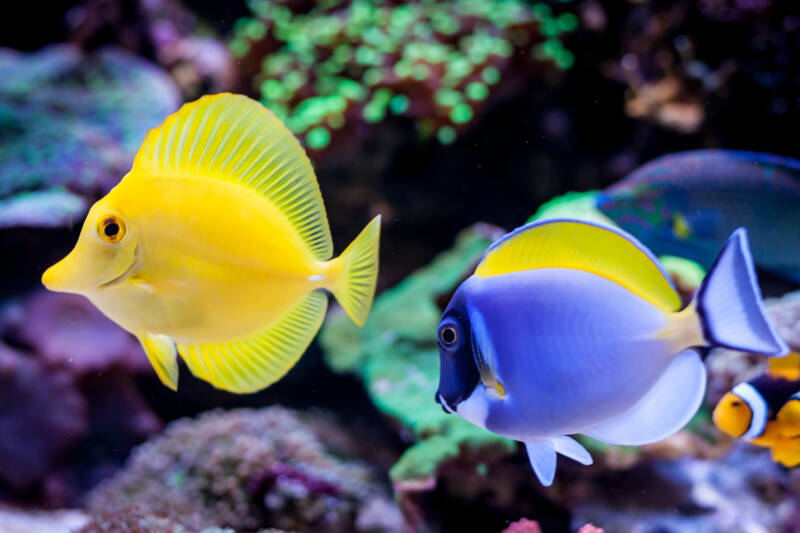There is no denying the allure of a saltwater fish tank. The variety of colorful species available is positively mind-blowing!

As fun as it can be, having these choices can sometimes make it difficult to determine what kind of saltwater fish would be best.
Consider your answers to the following questions, then check out our list of amazing fish!
[toc]
Popular Saltwater Fish
Personal preferences aside, there are many things to consider when selecting a fish both for a brand-new setup as well as to add to an existing tank.
When putting together this list, we looked at fish that would work within a peaceful community tank and excluded overly aggressive species.
1. Pajama Cardinalfish (Sphaeramia nematoptera)
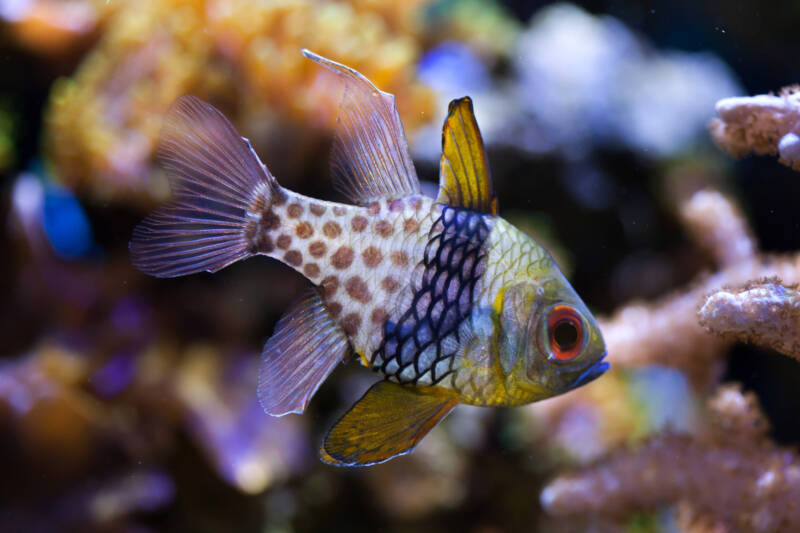
Minimum Tank Size: 30 gallons (114 l)
Specific Gravity: 1.023 – 1.025
The pajama cardinalfish certainly wins in the unique look category. They are distinguished by a dark vertical stripe mid-body and an adorable polka dot pattern extending to the base of the tail.
Of the 345 identified cardinalfish species in 32 genera, the most common for home aquariums are the pajama and Banggai.
This three-inch-long (7.6 cm) fish is a mouthbrooding species where the male keeps the young in his mouth as they develop.
Pajamas are best kept in groups of at least five, where they can pair off naturally as they mature.
Allow your aquarium, including the live rock, inoculated substrate, and any invertebrates, a few months to stabilize before adding the cardinal as your first fish.
2. Banggai Cardinalfish (Pterapogon kauderni)
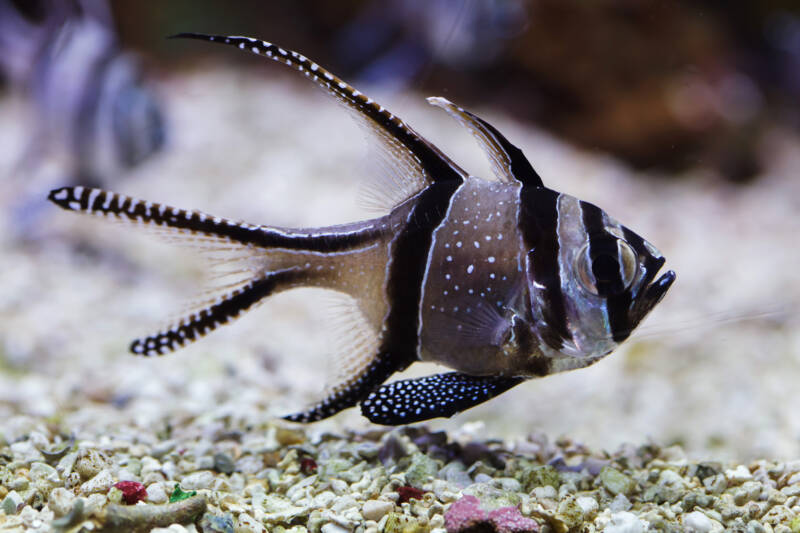
Minimum Tank Size: 30 gallons (114 l)
Specific Gravity: 1.023 – 1.025
The Banggai cardinalfish brings sparkle to your tank with its silver body, black stripes, and spotted fins. In a group, they are mesmerizing!
The IUCN Red List notes that the Banggai cardinalfish is an endangered species. It is endemic to the Banggai Archipelago of eastern Indonesia and has an extremely limited habitat.
These fish are caught extensively for aquarium trade. When looking to purchase one, select a distributor with sustainable practices.
Captive-bred specimens are hardy and easier to feed as they are already accustomed to flake or pellet foods. Offer vitamin-enriched foods and intersperse these feedings with live or frozen foods.
Their tank should have plenty of live rock. If you have a group of fish and some begin pairing off, keep an eye out for aggression toward the “odd fish out” and remove them if necessary.
If you are lucky, you may see your male Banggai cardinalfish mouthbrooding young fish.
3. Clownfish (Amphiprion sp.)

Minimum Tank Size: 20 gallons (76 l)
Specific Gravity: 1.020 – 1.024
Thanks to the movie Finding Nemo, most of us can easily identify a clownfish.
The most popular clownfish species in home aquariums are the ocellaris and percula. If you want different coloration and stripe configurations, check out the tomato, clarkii, or snowflake types.
These playful fish can be found riding powerhead currents or even sleeping upside down!
They are hardy fish that can be easy to care for if you are familiar with saltwater aquarium upkeep.
If you want your clownfish to live in an anemone, be sure to learn the ins and outs of anemone care.
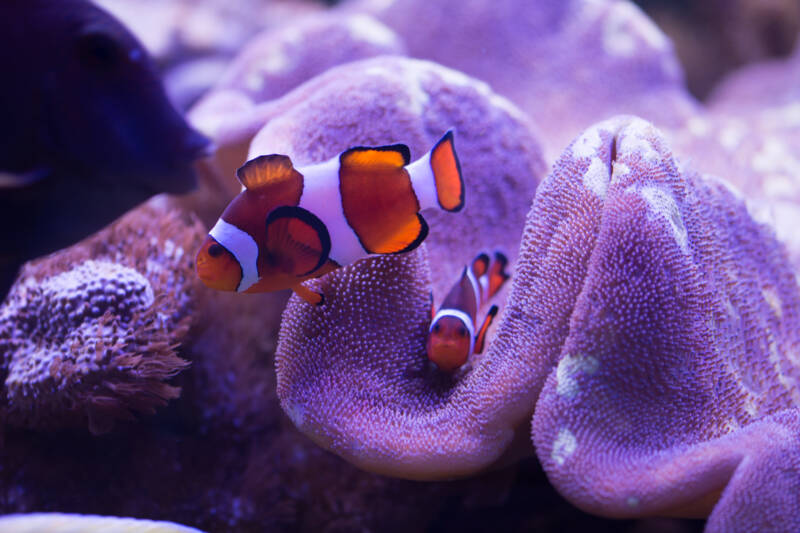
A fantastic setup would be a mated clownfish pair in a 20-gallon (75 l) tank.
Give them around 20 pounds of live rock and do not forget a quality heater, Hydor filtration system, and protein skimmer.
4. Court Jester Goby (Koumansetta rainfordi)
Minimum Tank Size: 10 gallons (38 l)
Specific Gravity: 1.020 – 1.025
Long and thin, featuring horizontal orange stripes on a blue/green body, the court jester goby is sure to be a conversation starter.
A fabulous member of a saltwater tank cleanup crew, this fish feeds by sifting through sand and eating a range of algae, including cyanobacteria, filamentous algae, hair algae, and red slime algae.
They will even eat algae from the aquarium glass!
While wild-caught specimens are slightly better at these cleaning skills, they can be difficult to acclimate to captivity as their diet is difficult to accommodate.
Captive-bred specimens, however, are much easier to feed and can be trained to accept pellet and frozen foods.
Keep only one court jester goby per tank. They do not bother other species and are peaceful tank mates; however, they can fight among themselves.
5. Spotted Mandarin Fish (Synchiropus splendidus)
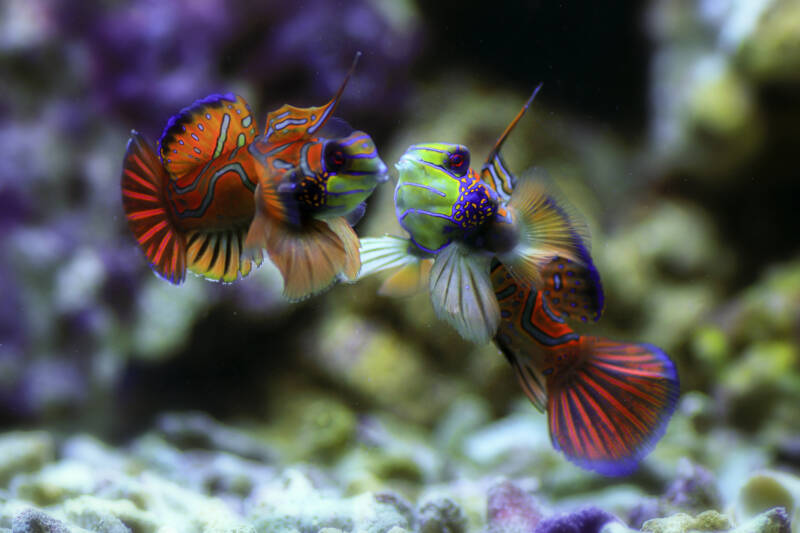
Minimum Tank Size: 30 gallons (114 l)
Specific Gravity: 1.023 – 1.025
The spotted Mandarin fish packs an impressive amount of color and pattern into a compact, three-inch (7.6 cm) long frame.
They are brilliantly decorated in blue, turquoise, orange, and yellow/green with rounded pelvic fins and flaring, translucent pectoral fins.
They are peaceful with other tank mates and spend their time hunting along the substrate for pods and brine shrimp.
They can be picky eaters, especially wild-caught specimens. However, captive-raised ones will eat pellet food.
Because they are scaleless, care should be taken to ensure top water quality.
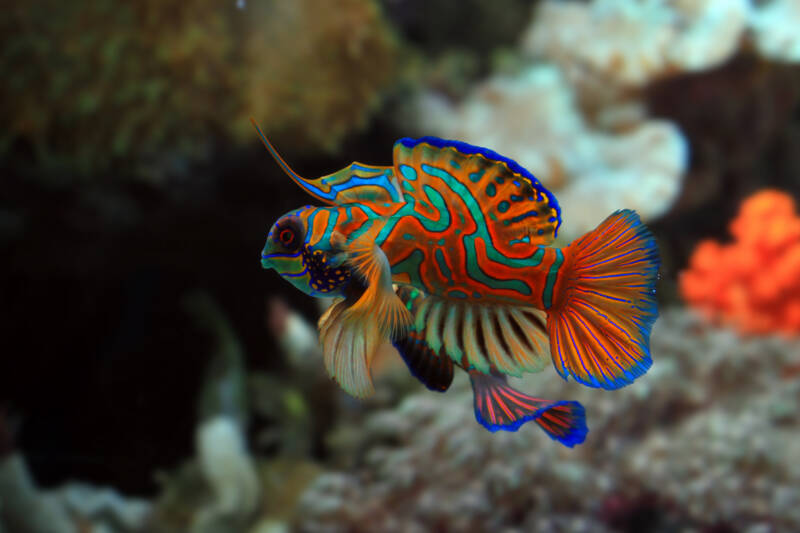
Keep these fish in male/female pairs and avoid keeping multiple males in the same tank to prevent territorial behavior.
Add in plenty of hiding spaces for this fish to retreat when frightened and a significant amount of live rock.
6. Blue Damselfish (Chrysiptera cyanea)
Minimum Tank Size: 30 gallons (114 l)
Specific Gravity: 1.020 – 1.025
The blue damselfish is a beautifully colored, reef-safe fish that can help with algae in the tank.
Males have blue tails with dark borders or bright orange tails. Females have clear tails with a spot near the tail base.
Damselfish are extraordinarily hardy. They easily acclimate to aquarium living, eat a wide range of foods, and readily spawn in captivity.
They do not shoal or school and can be kept in pairs in a small tank and in a good-sized group in a medium to large one.
Include plenty of hiding spaces and only house multiple males in a large tank.
This fish is better suited to community tank life when it is younger. As damselfish age, they may turn on peaceful tank mates.
Cohabitants should be selected with care as damselfish may be aggressive toward cardinalfish, gobies, firefish, and blennies.
7. Blue Reef Chromis (Chromis cyaneus)
Minimum Tank Size: 15 gallons (57 l)
Specific Gravity: 1.020 – 1.025
The vividly colored blue reef chromis is a hardy species that reaches an average length of five to 5.5 inches (12.7 to 14 cm).
Lithe and agile, these fish are completely reef safe and highly active, which is a benefit if you have other shy species in the tank.
They are easy to feed and accept a variety of commercial, live, and frozen foods.
A 15-gallon (55 l) tank is the minimum size to consider if you are keeping a single blue reef chromis by itself. If there are other tank mates, plan on at least 30 gallons (100 l).
As these fish are aggressive toward their own kind, a single specimen with or without other species is the safest bet.
These fish need a well-cycled tank and keen attention to monitoring nitrite and nitrate levels.
Always quarantine a blue reef chromis before adding them to the tank.
8. Royal Gramma Basslet (Gramma loreto)
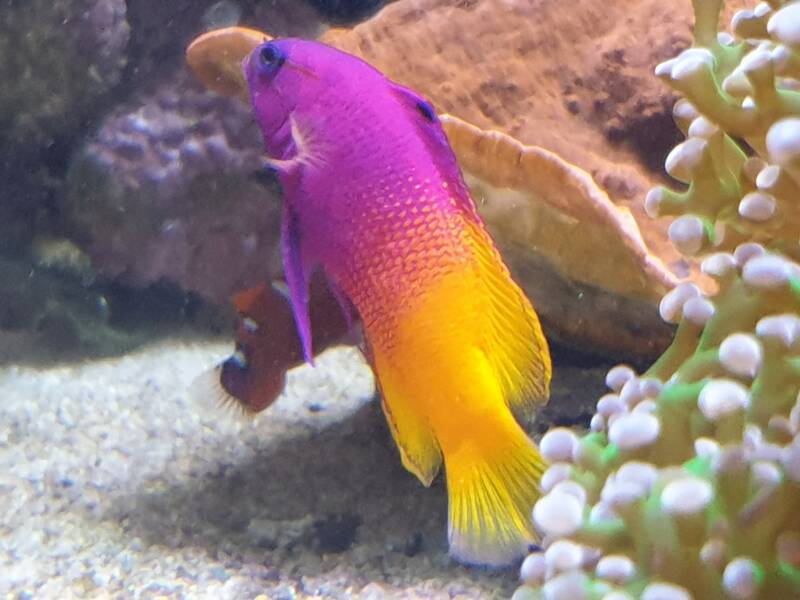
Minimum Tank Size: 30 gallons (114 l)
Specific Gravity: 1.020 – 1.025
With their pop of purple and yellow color, the royal gramma basslet is eye-catching.
These three-inch-long (7.6 cm) fish are planktivores. They thrive on a diet of zooplankton and phytoplankton in the wild but, in captivity, will eat flake, pellet, and frozen foods.
The basslet is shy and most active during feeding times.
They are gentle in nature but may become aggressive as they age.
Territorial aggression toward other basslets can occur if they are kept in too small of a tank. For each basslet, allot 30 gallons of tank space.
Take care to avoid confusing the basslet with the similar-looking royal dottyback (Pictichromis paccagnellae).
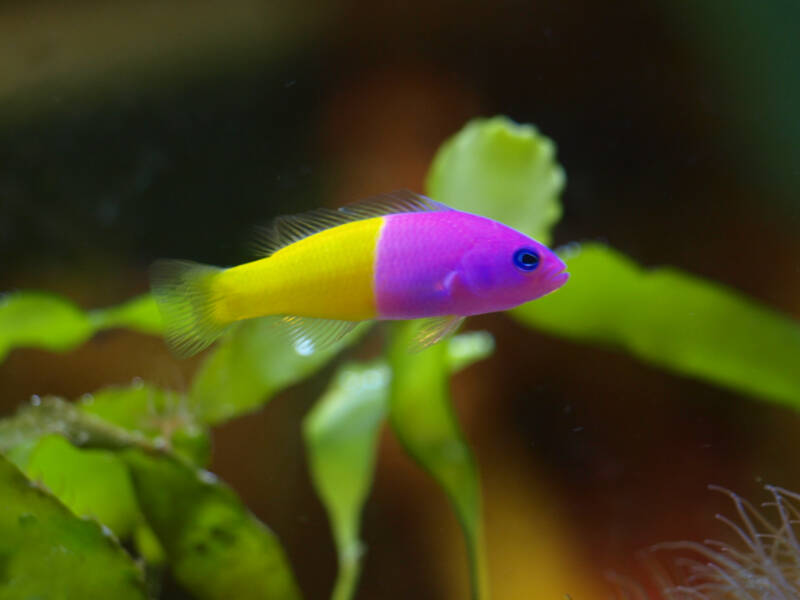
The dottyback is significantly more aggressive and less compatible with other species.
To tell the difference between the two, note that the basslet’s purple and yellow colors gently blend while the dottyback’s have a distinct line.
9. Purple or Magenta Dottyback (Pictichromis porphyrea)

Minimum Tank Size: 30 gallons (114 l)
Specific Gravity: 1.020 – 1.025
The purple dottyback is well-loved for its vibrant purple color.
Sometimes called the magenta dottyback, this fish is extraordinarily hardy and easy to care for, making it a perfect starter fish. They require a tank size of 30 gallons (110 l) for a single fish.
If you have multiple dottybacks, increase the tank size and introduce the fish simultaneously.
While they mix well in a community tank, the purple dottyback will select a territory/hiding space and vigorously guard it against similar-looking fish.
Avoid keeping this fish with basslets, other dottyback species, or fish with similar coloration to keep aggression down.
Purple dottybacks should be the last fish introduced to the tank as they may pick on fish introduced after them.
Place plenty of live rock in a well-cycled tank to provide multiple hiding places and varied line of sight. These fish are known to jump, so a tight-fitting tank cover is a necessity.
10. Six-Line Wrasse (Pseudocheilinus hexataenia)
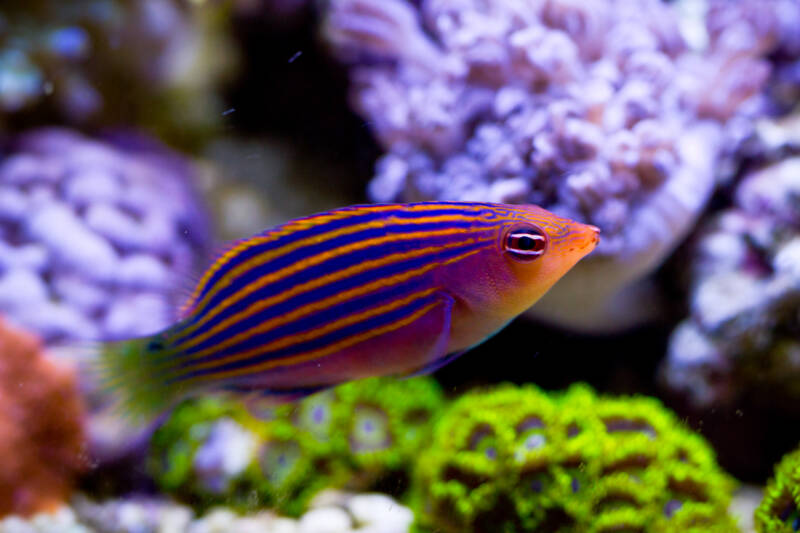
Minimum Tank Size: 30 gallons (114 l)
Specific Gravity: 1.020 – 1.025
These charismatic fish are highly active swimmers that need a significant amount of space, open rockscape, and a large, long tank.
They occupy all levels of the water column and sleep in a mucus cocoon to protect against nighttime predators.
The six-line wrasse is considered a semi-aggressive, territorial fish. Once they select a spot, they will aggressively defend it both against other wrasse and against fish of similar size and color.
As a result, they should be the last fish you add to your aquarium. Any fish added after them may be subject to aggression.
Avoid housing the six-line wrasse with peaceful species, as they will bully them, or with cleaner shrimp, as these will be eaten.
Watch your tank around feeding time. Your six-line wrasse may outcompete its tank mates for food, especially once it is mature.
11. Flame Hawkfish (Neocirrhites armatus)
Minimum Tank Size: 40 gallons (151 l)
Specific Gravity: 1.020 – 1.025
The vividly red flame hawkfish is not the reef’s best swimmer.
They lack a swim bladder to give them buoyancy and instead scoot along the substrate or rocks using their pectoral fins.
Like its namesake bird of prey, these fish are carnivorous ambush hunters that strike from above. They find their hiding positions among rocks and corals, so it is best to mimic this environment in their tank.
You may be amused to find this unique fish watching you intently from its perch.
The hawkfish is reef safe and will not nip your coral polyps; however, it can damage them with its perching and hunting habits.
In addition, it may prey on small invertebrates or members of your tank cleanup crew.
These fish startle easily, and for bottom dwelling, poor swimmers, they are remarkable jumpers! Ensure that any escape routes in your tank lid are securely covered.
12. Yellow Tang (Zebrasoma flavescens)
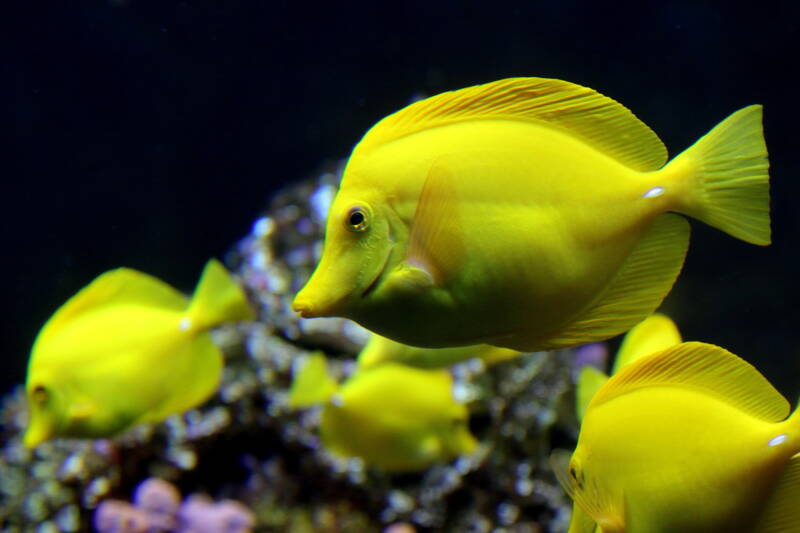
Minimum Tank Size: 90 gallons (340 l)
Specific Gravity: 1.020 – 1.026
The highly active, brightly colored yellow tang is everything you could want in a reef aquarium species.
Their classic shape and fantastic personality combine with a surprising ease of care.
Yellow tangs are members of the surgeonfish family. As such, be aware that they have razor sharp spines at the base of their tail that they use for defense.
Take care when transporting these fish and always use a solid container (never a net) to catch them.
These fish are friendly herbivores that need significant swimming space. If kept in smaller tanks, they can become stressed, aggressive, and prone to illness.
They grow to be around eight inches (20 cm) in length and are almost as tall as they are long.
In the wild, these algae eaters tackle growths on coral reefs, thereby helping them to not be overrun.
In an aquarium, plan on plenty of corals and rocks along the tank bottom to encourage algae growth on which your yellow tang can feed.
13. Powder Blue Tang (Acanthurus leucosternon)
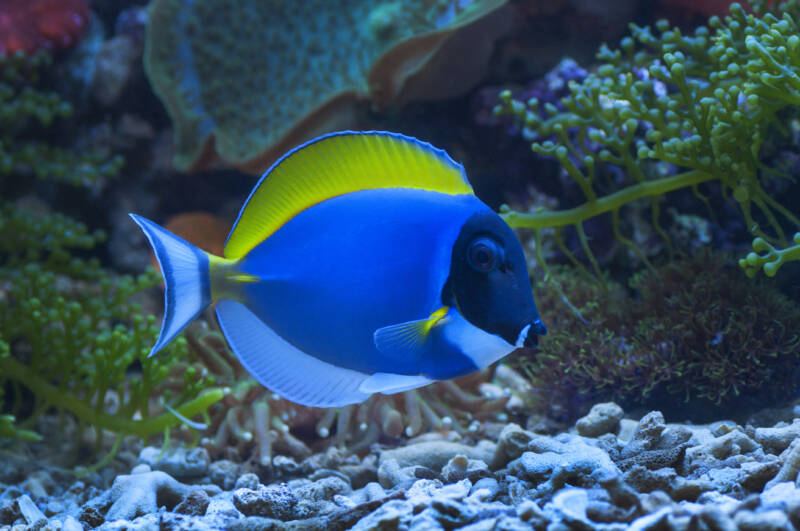
Minimum Tank Size: 125 gallons (470 l)
Specific Gravity: 1.021 – 1.025
The powder blue tang is a gorgeous species with its blue body trimmed in yellow and black.
These fish have a delightful personality but can be somewhat tricky to maintain in a home aquarium and are best for those with some experience in keeping marine fish tanks.
Plan on providing a massive amount of swimming space and territory for this fish as well as substantial, mature algae growth.
Their natural tendency to establish sizable territories can lead to aggression in a home aquarium if the powder blue tang resides with other fish, especially surgeonfish.
While they are hardy in the wild, the process of capture and transport occasionally results in sickly specimens.
Be sure to purchase from a reputable distributor, screen the fish for signs of disease, and quarantine them for at least a month before placing them in your aquarium.
14. Blue Tang (Paracanthurus hepatus)
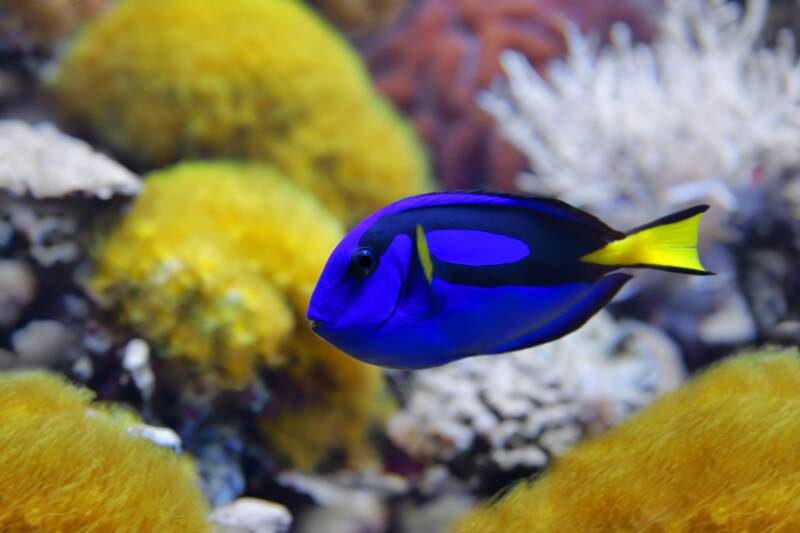
Minimum Tank Size: 90 gallons (340 l)
Specific Gravity: 1.020 – 1.025
The instantly recognizable blue tang is a favorite for reasons beyond its Finding Nemo movie fame.
These tangs are one of the more easy-to-care-for saltwater aquarium fish.
They are less of a picky eater than their powder blue cousins and accept a wide variety of foods.
You will need a large, long tank as this tang species loves to swim.
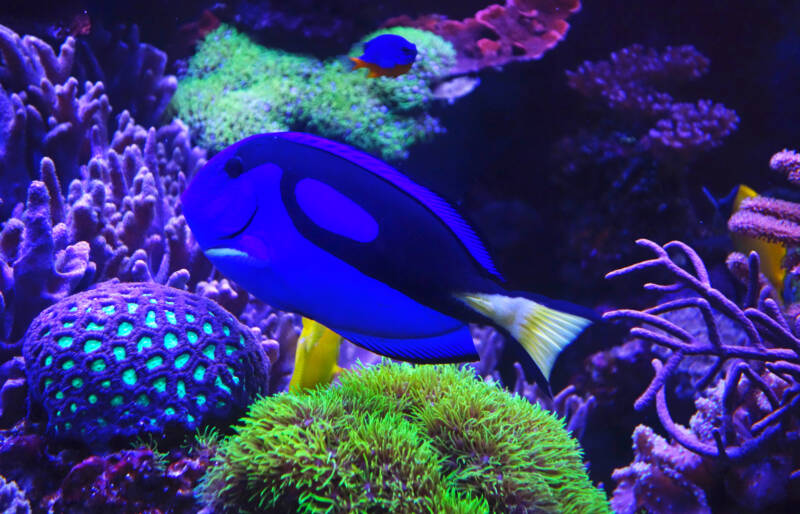
Ensure the tank is mature and well cycled before adding your blue tang and install powerheads or wave makers to provide the well-oxygenated water this fish needs.
Do not forget to add hiding spaces, as these will reduce your fish’s stress levels.
As with other surgeonfish, the blue tang does best as a single specimen.
If you plan to have multiple blue tangs, introduce them to the tank at the same time and make sure they are around the same size.
15. Flame Angelfish (Centropyge loricula)
Minimum Tank Size: 55 gallons (200 l)
Specific Gravity: 1.020 – 1.025
The flame angelfish is a striking centerpiece for any marine aquarium. These fish are typically wild caught but have little trouble acclimating to aquarium life.
You will need to quarantine a new fish, however, and they are prone to ich if kept in substandard conditions.
Flame angelfish are a bit smaller than other marine fish, typically reaching between four to six inches (10 to 15 cm) in length.
You can keep them with a range of aquatic species, but they are often intolerant of other angelfish and should always be the last fish added to the tank.
This fish is marginally reef safe. While they will not typically bother other fish or invertebrates, they can nip at your corals.
This tendency comes down to the individual temperament of the fish, so keep an eye on how your fish behaves when first introduced to the tank.
16. Algae Blenny (Salarias fasciatus)

Minimum Tank Size: 55 gallons (200 l)
Specific Gravity: 1.020 – 1.025
This fish is an adept algae eater. They are so good at their job that they run the risk of starvation if they go through the food supply too quickly, so plan to supplement their diet with nori and algae wafers.
This fish loves to snack on filamentous algae but ignores other types, such as slime or bubble algae.
The best environment for the algae blenny is a well-established tank with steady algae growth.
They are a peaceful species but can choose a favorite area of the tank and put up spirited defenses, especially against other blennies.
Take care when introducing this fish to a reef tank. Individuals can nip at stony corals or clam mantles.
In addition, their feeding behavior can disturb sediment (which is a good thing) or knock over poorly secured corals (which is not).
17. Midas Blenny (Ecsenius midas)
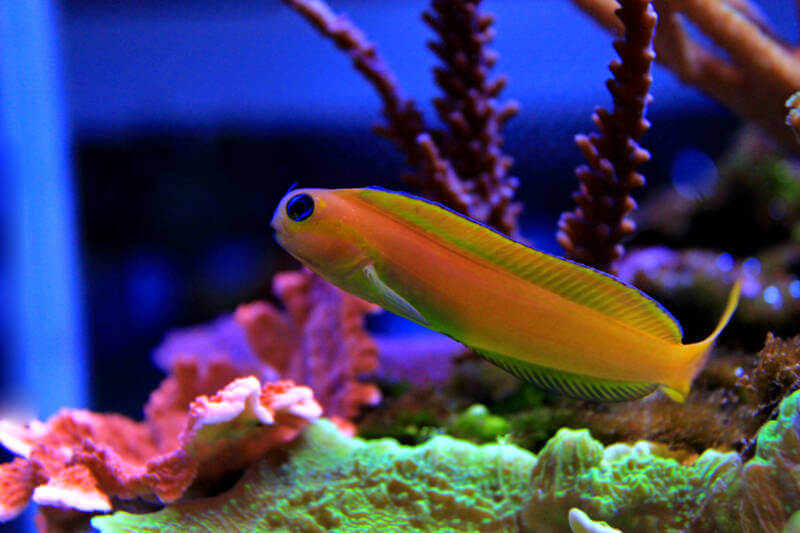
Minimum Tank Size: 30 gallons (120 l)
Specific Gravity: 1.020 – 1.025
Similar to its namesake king, the Midas blenny brings a flash of gold to your aquarium.
They are a smaller, four-to-six-inch (10 to 15 cm) size and hardy enough to be considered a beginner fish.
As long as a good mix of both meaty and vegetable-based foods are provided, this fish is easy to feed.
Personality-wise, Midas blennies are peaceful and quite shy. In fact, you may occasionally have difficulty locating them in the tank.
Once acclimated, however, they enjoy perching on rocky outcrops and observing the tank.
Midas blennies can present varying colors depending on their region of origin.
They can also shift colors to appear gold, yellow, orange, red, or even brown depending on where they are swimming in the tank and if they are schooling with other fish.
If you notice darker colors, these could be an indicator of stress.
18. Lyretail Anthias (Pseudanthias squamipinnis)
Minimum Tank Size: 125 gallons (470 l)
Specific Gravity: 1.020 – 1.026
If you are looking for an active fish to help calm and draw out your shy species, the lyretail anthias is an excellent choice.
You will find this fish exploring all levels of the water column. In fact, their activity level is so high, they need multiple daily feedings to keep up with their metabolism.
They are reef safe but avoid housing them with small ornamental shrimp, as these may end up on the menu.
A school of all females or a group of females with a single male works best. Multiple males in the tank will fight for control of the harem.
The lyretail anthias need multiple places to shelter and hide. This gives them the opportunity to rest and escape the bright lighting needed to maintain corals.
A large tank size for this five-inch (13 cm) fish helps balance adequate swimming space with sufficient coral and rock formations.
19. Banded Pipefish (Dunckerocampus dactyliophorus)
Minimum Tank Size: 30 gallons (114 l)
Specific Gravity: 1.020 – 1.025
Elegantly long and thin, with perfectly alternating light and dark stripes, the banded pipefish may be one of the more unique-looking fish you can get.
Known to clean parasites off moray eels in the wild, this slow-moving creature can be challenging to feed in a home aquarium.
Their long snouts, from which they get their name, contain fused jaws. They open a flap at the end of their snout to inhale prey.
The pipefish’s digestive system is tiny, so they need a steady supply of live, small-sized food.
These carnivorous hunters love copepods, but you may find they run out of food quickly, even in a mature tank. Captive-bred pipefish may better accept a variety of foods.
The banded pipefish is best for those with some experience. In addition to their dietary needs, they have specific water requirements.
The calcium-rich, plate-like armor that protects their body necessitates a high level of calcium in their water.
20. Purple Firefish (Nemateleotris decora)
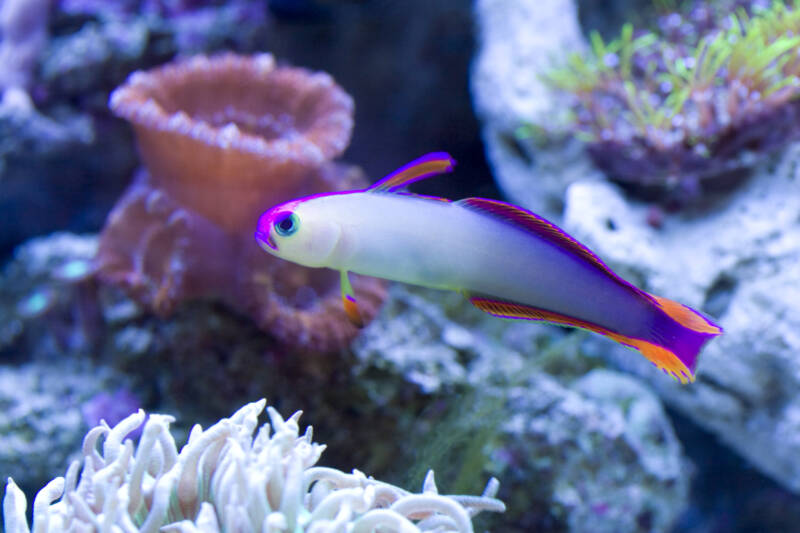
Minimum Tank Size: 10 gallons (40 l)
Specific Gravity: 1.020 – 1.025
Purple firefish pack an immense amount of color into their tiny, four-inch (10 cm) length.
This peaceful bottom feeder sticks to the lower portion of the water column, where it forages for food.
These fish are low-cost, easy to feed, and hardy, making them an excellent choice for a beginner.
They have a solitary nature, even in the wild, and may show aggression if you keep more than one in your tank. That said, they get along with a wide variety of reef tank mates, including invertebrates, and will not harm your corals.
The purple firefish is on the shy side. You may find them nestled into a cave or under a favorite rock structure.
They can even burrow into the substrate, so line the tank bottom with softer sand!
21. Neon Blue Goby (Gobiosoma oceanops)
Minimum Tank Size: 30 gallons (114 l)
Specific Gravity: 1.020 – 1.025
The neon blue goby is long, slender, and features a stunning blue stripe running the length of its body.
In the wild, these fish establish “cleaning stations,” where other species can come to have parasites removed. They will perform similarly in a home aquarium but will need supplemented meals of meaty foods.
They are peaceful fish that love clinging to rock surfaces and surveying the tank.
Neon blue gobies can become aggressive when a bonded pair establishes a territory prior to mating.
However, if the tank is large enough and the group size is around six to eight gobies, then the aggression level will be lower.
They are a well-known “jumping fish” that can find their way out through the smallest opening. Make certain that all possible escape routes are covered, and your tank lid fits well.
22. Lemon Peel Angelfish (Centropyge flavissima)

Minimum Tank Size: 30 gallons (114 l)
Specific Gravity: 1.020 – 1.025
The lemon peel angelfish is a bright yellow color trimmed around the eyes, gills, and fins with vivid blue.
Interestingly, all lemon peels are born female. Eventually, the dominant fish will become male.
This angelfish has a feisty personality for a smaller species. Avoid placing multiple males in the same tank as they can fight to the death.
This fish can also take on other species, especially those that resemble it and will not be kind to any lemon peel angelfish introduced after it.
Keep these fish as a single specimen, in mated pairs, or in trios.
If you have LPS corals, this fish is not for you. The omnivorous lemon peel will nibble these polyps as well as some soft corals.
Their preferred food is algae, so they need a large, mature tank. It can be challenging to get them to accept prepared foods.
23. Blue-Spotted Jawfish (Opistognathus rosenblatti)
Minimum Tank Size: 30 gallons (114 l)
Specific Gravity: 1.020 – 1.025
This burrowing, cave-building species digs a home in the substrate and tends to hang out there.
The burrow depth can be significant, so a thick, six-inch (15 cm) substrate and safe anchoring of rocks and corals are necessary.
Do not forget a lid or screen, as these fish can jump!
It is best to keep this fish as a single specimen unless you have a very large tank. For multiple jawfish, you will need to allocate two to three feet of floor space for each fish.
These fish cannot thrive in a warm, tropical reef tank. They need cool water temperatures that are between 74 to 76°F (23-24,4°C), which may require special equipment.
Blue-spotted jawfish are carnivores that feed off zooplankton directly from the water column. They favor live prey and can be fussy when it comes to other types of food.
Jawfish are reef safe and do well in a tank with calm, slower swimming fish.
24. Pearly Jawfish (Opistognathus aurifrons)
Minimum Tank Size: 30 gallons (114 l)
Specific Gravity: 1.020 – 1.025
If you like the idea of a jawfish but are put off by the care the blue-spotted variety needs, then consider the less expensive, easy to care for pearly jawfish.
While you will still need a decently sized tank, thick sand substrate, and a well-fitting tank lid, the pearly jawfish is less demanding than its spotted cousin.
You can have warmer water temperatures in the tank, too. Their preferred temperature range of 75 to 85°F (24-29.4°C) means a wider range of compatible reef fish.
They are less picky when it comes to feeding time and can learn to accept a range of meaty foods. Pearly jawfish also do not require the constant frequent feedings that blue-spotted jawfish do.
Pearly jawfish are hardy, more disease-resistant, and do not contract blue-spotted jawfish disease. However, you should still plan to quarantine them before introducing them to your tank.
25. Coral Beauty Angelfish (Centropyge bispinosa)
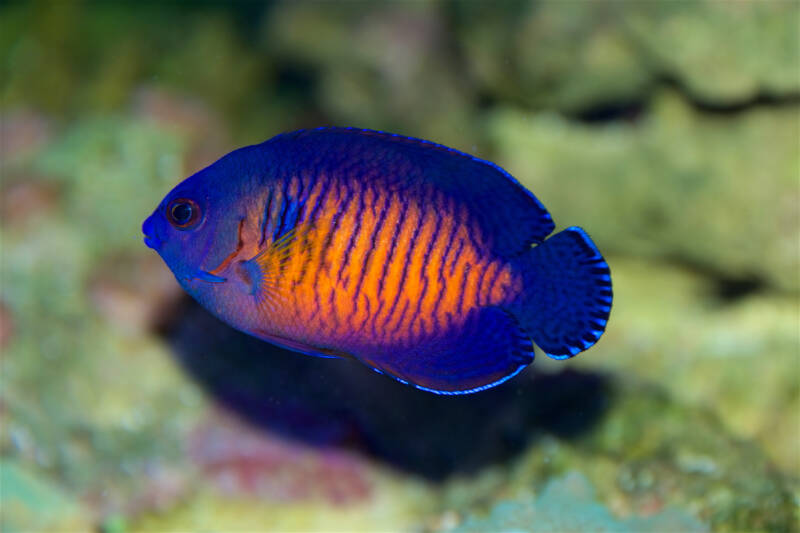
Minimum Tank Size: 30 gallons (114 l)
Specific Gravity: 1.020 – 1.025
The coral beauty angelfish is one of the hardiest dwarf angelfish species you can find.
They may be smaller, four inches (10 cm) in length, but they have feisty personalities and are best suited for medium to large tanks.
Their personality quirks require some care when selecting tank mates. They may not get along with other angelfish species and can nip at invertebrates.
Place them last into the tank with larger or similarly sized species.
The popular coral beauty can be easier to feed than other angelfish. They graze primarily on algae growing on live rocks but will also accept other foods.
If you are considering coral beauties for a reef aquarium, use caution, as these fish can nip at coral polyps, especially LPS corals.
They need a good amount of live rock in their tank and a large open swimming space.
26. Raccoon Butterfly (Chaetodon lunula)
Minimum Tank Size: 75 gallons (280 l)
Specific Gravity: 1.020 – 1.025
The raccoon butterfly fish reaches a sizable six to eight inches (15 to 20 cm) in length, features bright colors, and has an agreeable temperament.
Their colors can brighten or fade depending on the time of day or their level of comfort.
They are peaceful around other fish species but can be territorial with their own kind.
These fish are typically active at night, but you may convince them to be diurnally active in a tank with low lighting.
Take care when selecting tank mates. The raccoon butterfly fish does not get along with other territorial species and can prey on smaller invertebrates.
Butterfly fish, in general, can be rough on corals. While the raccoon may be a slightly more compatible species, they still may not be completely safe for a reef tank.
27. Lagoon or Picasso Triggerfish (Rhinecanthus aculeatus)
Minimum Tank Size: 125 gallons (470 l)
Specific Gravity: 1.020 – 1.023
A hardy and highly disease-resistant fish, they favor shallow coral reefs and, as their name implies, lagoons.
In captivity, a juvenile triggerfish will do fine in a 75-gallon (280 l) tank, but you will eventually need to move them to a larger tank. Fortunately, they grow slowly, so you have some time to upgrade.
These fish need a large tank size for several reasons.
First, they love to swim and have high activity levels. They also bring a high bio-load, which will be more manageable in a larger tank. Finally, they can become aggressive as they grow, so additional space is best.
This aggression can also make it tricky to find ideal tank mates.
Consider pairing them with other similarly sized, semi-aggressive or bold fish, such as tangs, angels, puffers, other triggers, or the raccoon butterfly.
28. Biota Captive-Bred Aiptasia Eating Filefish (Acreichthys tomentosus)
Minimum Tank Size: 30 gallons (114 l)
Specific Gravity: 1.023 – 1.025
If your tank is overrun with nuisance anemones, the aiptasia-eating filefish may come to the rescue.
This filefish has a mellow personality and is well known for its ability to not only eat but decimate aiptasia in your tank.
They have a unique camouflaging capability and interesting fin configuration.
While you typically purchase them as small, one-inch (2,5 cm) fish, they will quickly grow to their four-inch (10 cm) adult length.
As captive-bred fish, they are accustomed to the conditions found in home aquariums and slightly more forgiving of imperfect water conditions. These fish would be excellent for a beginner to aquarium keeping.
This fish can nip at your soft or stony corals, so take care when introducing them to a reef tank.
They can be aggressive toward their own kind and should be housed with peaceful fish of similar size for the best results.
Questions to Ask Before Buying a New Fish
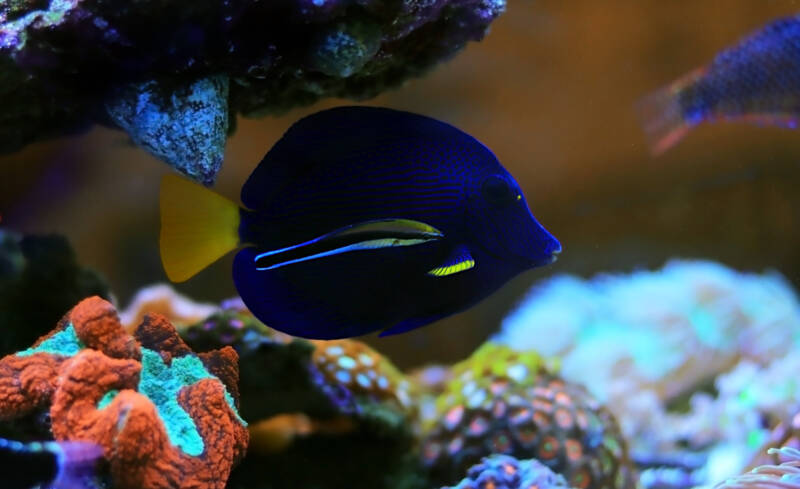
We cannot overemphasize the importance of researching the fish species before adding them to your tank.
Determining the answers to the following questions can prevent the need to rehome or return a fish.
Peaceful or Aggressive?
What type of tank are you wanting? A community reef tank works best with peaceful species that can coexist without fighting, feeding difficulties, or the like.
In addition, keeping peaceful species together means less stress and a longer lifespan for your fish.
What Size Tank Will You Need?
Consider the following when determining tank size:
- What is the eventual adult size of the fish?
- Is the fish an active swimmer (i.e., tang fish)?
- Do they need a long or tall tank?
- Do they require a sizable territory?
- Does the fish eat primarily algae (needing a larger tank to allow algae growth)?
What Specific Care Does the Fish Require?
Is it a hardy fish or one that has strict water needs? What is your level of expertise, and are you prepared to care for a more challenging species?
What Foods Does the Fish Need?
While some reef fish will eat anything you put in front of them, others are on highly specific diets.
Some feed mainly on algae and require a mature tank.
Others feast only on copepods, which you would need to cultivate and supply. Still others, especially wild specimens, hunt live prey and can refuse other foods.
Is the Fish Compatible with Your Tank Environment?
Do they need the same water parameters?
Some reef fish, such as the blue-spotted jawfish, are actually cool water fish that cannot survive in a warm reef tank.
Does the Fish School or Are They Solitary?
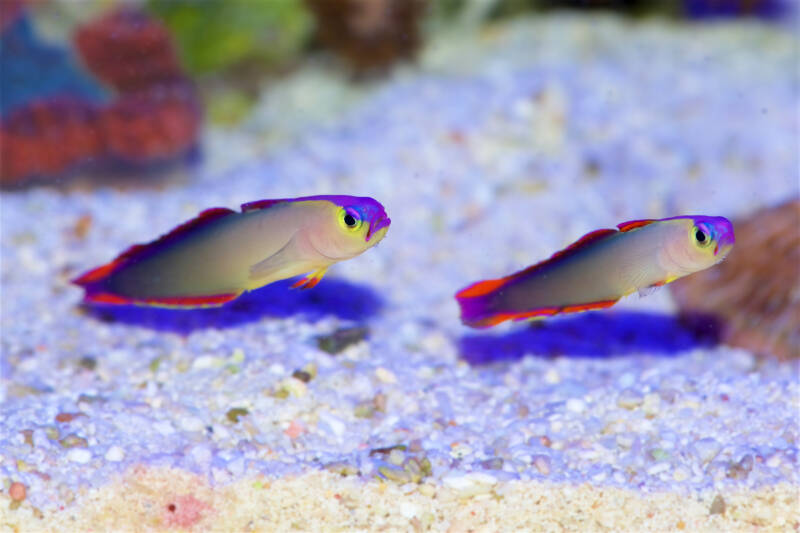
For schooling fish, determine the number needed and female-to-male ratios, if applicable. School size can impact the tank size you need.
If the fish can be kept as a solitary specimen, are there any species with which they cannot be kept (i.e., the royal gramma basslet cannot be housed with the similar-looking royal dottyback).
Is the Fish Best with Another Species?
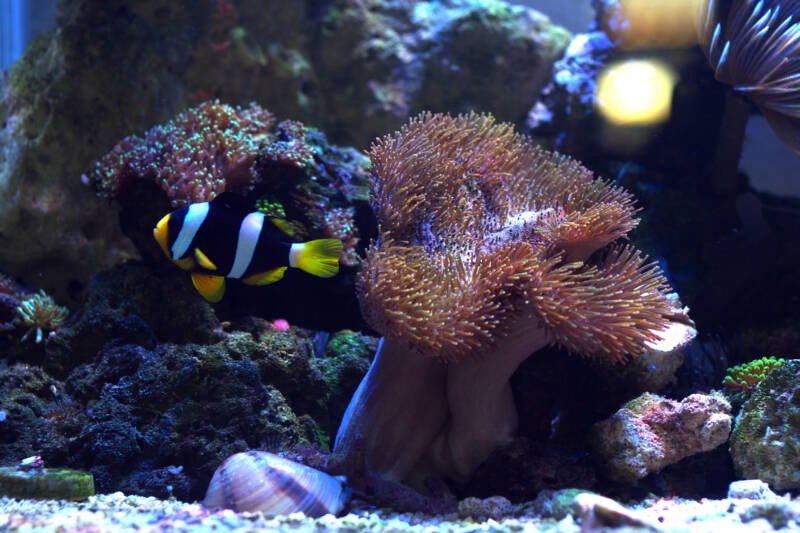
Some species have a symbiotic relationship, such as clownfish and anemones.
Gobies and shrimp each benefit from the other’s activities. Cleaner shrimp help your fish by removing parasites.
Consider these relationships that can bring a natural feel to your tank by replicating natural environments.
Is the Fish Reef Safe?
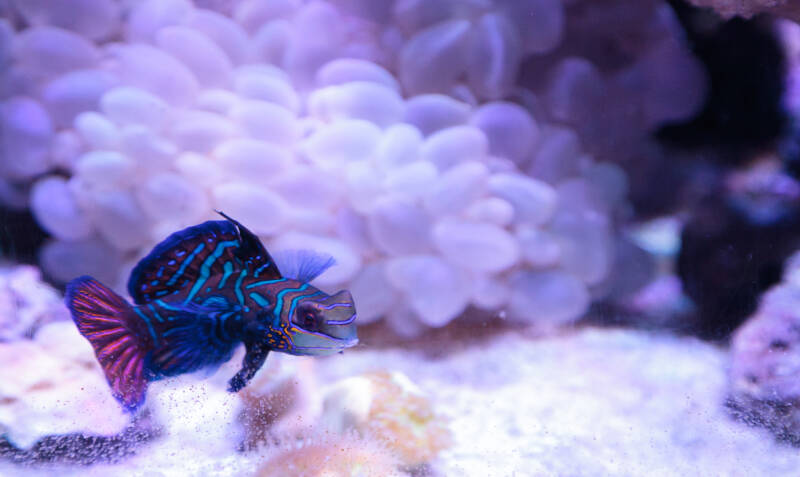
If you have a reef tank, consider whether the fish is reef safe or not.
Angelfish and some types of blennies can nip at coral polyps. Other species snack on invertebrates. Large fish can knock over coral formations.
If you are satisfied with your answers to these questions, then check out the awesome fish below!
Closing Thoughts
This list gives a good sampling of popular saltwater fish for home aquariums. If we missed one of your favorites, let us know in the comments below!

